MENU
The Electronic Scholarly Publishing Project: Providing access to classic scientific papers and other scholarly materials, since 1993. More About: ESP | OUR CONTENT | THIS WEBSITE | WHAT'S NEW | WHAT'S HOT
Comparative Timelines
The ESP Timeline (one of the site's most popular features) has been completely updated to allow the user to select (using the timeline controls above each column) different topics for the left and right sides of the display.
Select:
New Left Column
New Left Column
Dates
Decade
New Right Column
New Right Column
(no entry for this year)
1590
(no entry for this year)
(no entry for this year)
1591
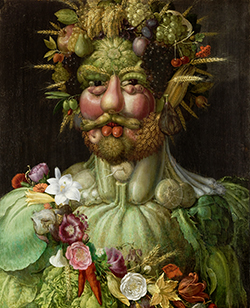 Painting by Giuseppe Arcimboldo: Vertumnus The painting is Arcimboldo's most famous work and is a portrait of the Holy Roman Emperor Rudolf II re-imagined as Vertumnus, the Roman god of metamorphoses in nature and life; the fruits and vegetables symbolize the abundance of the Golden Age that has returned under the Emperor's rule. Looking from the distance, Arcimboldo's whimsical portraits might look like portraits, but they are assembled using vegetables, books, plants, kitchen utensils, oils, fruits, sea creatures, animals and tree roots, each individual object chosen to give the impression of anatomical trait of a human face. The portrait of the emperor is created out of plants — flowers and fruits from all seasons: gourds, pears, apples, cherries, grapes, wheat, artichokes, peapods, corns, onions, artichoke, cabbage foils, cherries, chestnuts, figs, mulberries, grapes, plums, pomegranates, various pumpkins and olives. Rudolf's portrait is composed of fruit, vegetables and flowers were to symbolize the perfect balance and harmony with nature that his reign represented. These portraits were an expression of the Renaissance mind's fascination with riddles, puzzles, and the bizarre.
Painting by Giuseppe Arcimboldo: Vertumnus The painting is Arcimboldo's most famous work and is a portrait of the Holy Roman Emperor Rudolf II re-imagined as Vertumnus, the Roman god of metamorphoses in nature and life; the fruits and vegetables symbolize the abundance of the Golden Age that has returned under the Emperor's rule. Looking from the distance, Arcimboldo's whimsical portraits might look like portraits, but they are assembled using vegetables, books, plants, kitchen utensils, oils, fruits, sea creatures, animals and tree roots, each individual object chosen to give the impression of anatomical trait of a human face. The portrait of the emperor is created out of plants — flowers and fruits from all seasons: gourds, pears, apples, cherries, grapes, wheat, artichokes, peapods, corns, onions, artichoke, cabbage foils, cherries, chestnuts, figs, mulberries, grapes, plums, pomegranates, various pumpkins and olives. Rudolf's portrait is composed of fruit, vegetables and flowers were to symbolize the perfect balance and harmony with nature that his reign represented. These portraits were an expression of the Renaissance mind's fascination with riddles, puzzles, and the bizarre.
(no entry for this year)
1592
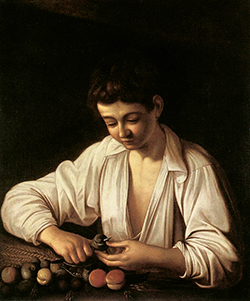 Painting by Caravaggio: Boy Peeling Fruit This is the earliest known work by Caravaggio, painted soon after his arrival in Rome from his native Milan in mid 1592. The fruit being peeled by the boy is something of a mystery. Sources indicate it may be a pear, which is probably correct but has been questioned; it may be a nectarine or plum, several of which lie on the table, but these are not usually peeled; some have suggested a bergamot, a pear-shaped citrus fruit grown in Italy, but others object that the bergamot is sour and practically inedible. Seen as a simple genre painting, it differs from most in that the boy is not 'rusticated,' that is, he is depicted as clean and well-dressed instead of as a 'cute' ragamuffin. An allegoric meaning behind the painting is plausible, given the complex Renaissance symbology of fruit. Caravaggio scholar John T. Spike has recently suggested that the boy demonstrates resistance to temptation by ignoring the sweeter fruits (fruits of sin) in favour of the bergamot, but no specific reading is widely accepted.
Painting by Caravaggio: Boy Peeling Fruit This is the earliest known work by Caravaggio, painted soon after his arrival in Rome from his native Milan in mid 1592. The fruit being peeled by the boy is something of a mystery. Sources indicate it may be a pear, which is probably correct but has been questioned; it may be a nectarine or plum, several of which lie on the table, but these are not usually peeled; some have suggested a bergamot, a pear-shaped citrus fruit grown in Italy, but others object that the bergamot is sour and practically inedible. Seen as a simple genre painting, it differs from most in that the boy is not 'rusticated,' that is, he is depicted as clean and well-dressed instead of as a 'cute' ragamuffin. An allegoric meaning behind the painting is plausible, given the complex Renaissance symbology of fruit. Caravaggio scholar John T. Spike has recently suggested that the boy demonstrates resistance to temptation by ignoring the sweeter fruits (fruits of sin) in favour of the bergamot, but no specific reading is widely accepted.
(no entry for this year)
1593
(no entry for this year)
(no entry for this year)
1594
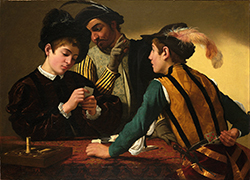 Painting by Caravaggio: Cardsharps The work represents an important milestone for Caravaggio. He painted it when he was attempting an independent career after leaving the workshop of the Cavaliere Giuseppe Cesari d'Arpino, for whom he had been painting "flowers and fruit", finishing the details for the Cavaliere's mass-produced (and massive) output. Caravaggio left Arpino's workshop in January 1594 and began selling works through the dealer Costantino, with the assistance of Prospero Orsi, an established painter of Mannerist grotesques (masks, monsters, etc.). Orsi introduced Caravaggio to his extensive network of contacts in the world of collectors and patrons. Composition The painting shows an expensively-dressed but unworldly boy playing cards with another boy. The second boy, a cardsharp, has extra cards tucked in his belt behind his back, out of sight of the mark but not the viewer, and a sinister older man is peering over the dupe's shoulder and signaling to his young accomplice. The second boy has a dagger handy at his side, and violence is not far away.
Painting by Caravaggio: Cardsharps The work represents an important milestone for Caravaggio. He painted it when he was attempting an independent career after leaving the workshop of the Cavaliere Giuseppe Cesari d'Arpino, for whom he had been painting "flowers and fruit", finishing the details for the Cavaliere's mass-produced (and massive) output. Caravaggio left Arpino's workshop in January 1594 and began selling works through the dealer Costantino, with the assistance of Prospero Orsi, an established painter of Mannerist grotesques (masks, monsters, etc.). Orsi introduced Caravaggio to his extensive network of contacts in the world of collectors and patrons. Composition The painting shows an expensively-dressed but unworldly boy playing cards with another boy. The second boy, a cardsharp, has extra cards tucked in his belt behind his back, out of sight of the mark but not the viewer, and a sinister older man is peering over the dupe's shoulder and signaling to his young accomplice. The second boy has a dagger handy at his side, and violence is not far away.
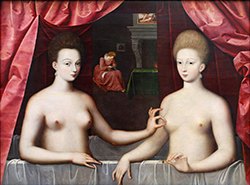 Painting by unknown artist: Gabrielle d'Estrées et une de soeurs The painting now hangs at the Louvre in Paris and is usually thought to be the work of a painter from the Fontainebleau School. The painting portrays Gabrielle d'Estrées, mistress of King Henry IV of France, sitting nude in a bath, holding a ring. Her sister sits nude beside her and pinches her right nipple. The nipple-pinching gesture is often interpreted as a symbolic announcement that Gabrielle is pregnant with Henry's child, César de Bourbon. According to the Louvre's website: "The oddly affectionate way in which the sister is pinching Gabrielle d'Estrées' right breast has often been taken as symbolizing the latter's pregnancy with the illegitimate child of Henry IV. This interpretation would seem to be confirmed by the scene of the young woman sewing — perhaps preparing a layette for the coming child — in the background." The ring that Gabrielle holds is said to be Henry's coronation ring, which he supposedly gave to her as a token of his love shortly before she died.
Painting by unknown artist: Gabrielle d'Estrées et une de soeurs The painting now hangs at the Louvre in Paris and is usually thought to be the work of a painter from the Fontainebleau School. The painting portrays Gabrielle d'Estrées, mistress of King Henry IV of France, sitting nude in a bath, holding a ring. Her sister sits nude beside her and pinches her right nipple. The nipple-pinching gesture is often interpreted as a symbolic announcement that Gabrielle is pregnant with Henry's child, César de Bourbon. According to the Louvre's website: "The oddly affectionate way in which the sister is pinching Gabrielle d'Estrées' right breast has often been taken as symbolizing the latter's pregnancy with the illegitimate child of Henry IV. This interpretation would seem to be confirmed by the scene of the young woman sewing — perhaps preparing a layette for the coming child — in the background." The ring that Gabrielle holds is said to be Henry's coronation ring, which he supposedly gave to her as a token of his love shortly before she died.
(no entry for this year)
1595
(no entry for this year)
(no entry for this year)
1596
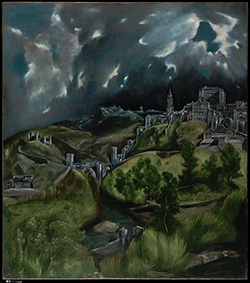 Painting by El Greco: View of Toledo is one of the two surviving landscapes painted by El Greco. The other, View and Plan of Toledo lies at Museo Del Greco, Toledo, Spain. View of Toledo is among the best known depictions of the sky in Western art, along with Vincent van Gogh's The Starry Night and the landscapes of William Turner and Monet, among others. Most notable is the distinct color contrast between the dark and somber skies above and the glowing green hills below. While influenced by the Mannerist style, El Greco's expressive handling of color and form is without parallel in the history of art. In this painting, he takes liberties with the actual layout of Toledo insofar as certain building locations are re-arranged. However, the location of the Castle of San Servando, on the right, is accurately depicted. El Greco's signature appears in the lower-right corner.
Painting by El Greco: View of Toledo is one of the two surviving landscapes painted by El Greco. The other, View and Plan of Toledo lies at Museo Del Greco, Toledo, Spain. View of Toledo is among the best known depictions of the sky in Western art, along with Vincent van Gogh's The Starry Night and the landscapes of William Turner and Monet, among others. Most notable is the distinct color contrast between the dark and somber skies above and the glowing green hills below. While influenced by the Mannerist style, El Greco's expressive handling of color and form is without parallel in the history of art. In this painting, he takes liberties with the actual layout of Toledo insofar as certain building locations are re-arranged. However, the location of the Castle of San Servando, on the right, is accurately depicted. El Greco's signature appears in the lower-right corner.
(no entry for this year)
1597
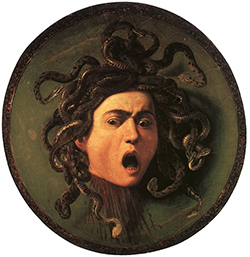 Painting by Caravaggio: Medusa Caravaggio painted two versions of Medusa, the first in 1596 and the other presumably in 1597. The first version is also known as Murtula, by the name of the poet who wrote about it, Gaspare Murtola (d. 1624): "Flee, for if your eyes are petrified in amazement, she will turn you to stone." It measures 48 by 55 cm and is signed Michel A F (Latin: Michel Angelo Fecit), "Michel Angelo made [this]", Michelangelo being Caravaggio's first name. This work is privately owned. The second version, shown here, is slightly bigger (60 × 55 cm) and is not signed; it is held in the Uffizi Gallery in Florence.
Painting by Caravaggio: Medusa Caravaggio painted two versions of Medusa, the first in 1596 and the other presumably in 1597. The first version is also known as Murtula, by the name of the poet who wrote about it, Gaspare Murtola (d. 1624): "Flee, for if your eyes are petrified in amazement, she will turn you to stone." It measures 48 by 55 cm and is signed Michel A F (Latin: Michel Angelo Fecit), "Michel Angelo made [this]", Michelangelo being Caravaggio's first name. This work is privately owned. The second version, shown here, is slightly bigger (60 × 55 cm) and is not signed; it is held in the Uffizi Gallery in Florence.
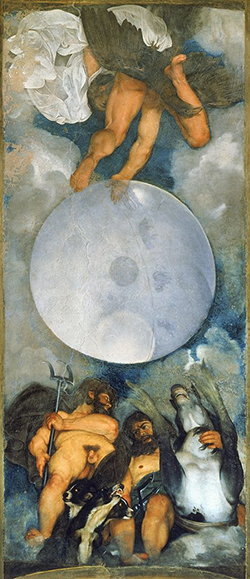 Painting by Michelangelo Merisi da Caravaggio: Jupiter, Neptune and Pluto According to an early biographer, one of Caravaggio's aims was to discredit critics who claimed that he had no grasp of perspective. The three figures demonstrate the most dramatic foreshortening imaginable. They contradict claims that Caravaggio always painted from live models. The artist seems to have used his own face for all three gods. The painting was done for Caravaggio's patron Cardinal Francesco Maria Del Monte and painted on the ceiling of the cardinal's garden casino of his country estate, which later became known as the Villa Ludovisi. The cardinal had a keen interest alchemy. Caravaggio has painted an allegory of the alchemical triad of Paracelsus: Jupiter stands for sulphur and air, Neptune for mercury and water, and Pluto for salt and earth. Each figure is identified by his beast: Jupiter by the eagle, Neptune by the hippocamp, and Pluto by the three-headed dog Cerberus. Jupiter is reaching out to move the celestial sphere in which the Sun revolves around the Earth. Galileo was a friend of Del Monte but had yet to make his mark on cosmology.
Painting by Michelangelo Merisi da Caravaggio: Jupiter, Neptune and Pluto According to an early biographer, one of Caravaggio's aims was to discredit critics who claimed that he had no grasp of perspective. The three figures demonstrate the most dramatic foreshortening imaginable. They contradict claims that Caravaggio always painted from live models. The artist seems to have used his own face for all three gods. The painting was done for Caravaggio's patron Cardinal Francesco Maria Del Monte and painted on the ceiling of the cardinal's garden casino of his country estate, which later became known as the Villa Ludovisi. The cardinal had a keen interest alchemy. Caravaggio has painted an allegory of the alchemical triad of Paracelsus: Jupiter stands for sulphur and air, Neptune for mercury and water, and Pluto for salt and earth. Each figure is identified by his beast: Jupiter by the eagle, Neptune by the hippocamp, and Pluto by the three-headed dog Cerberus. Jupiter is reaching out to move the celestial sphere in which the Sun revolves around the Earth. Galileo was a friend of Del Monte but had yet to make his mark on cosmology.
(no entry for this year)
1598
(no entry for this year)
(no entry for this year)
1599
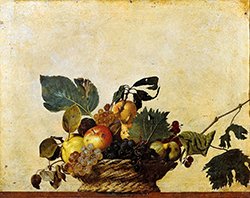 Painting by Caravaggio: Basket of Fruit a still life painting which hangs in the Biblioteca Ambrosiana (Ambrosian Library), Milan. It shows a wicker basket perched on the edge of a ledge. The basket contains a selection of summer fruit. Much has been made of the worm-eaten, insect-predated, and generally less than perfect condition of the fruit. In line with the culture of the age, the general theme appears to revolve about the fading beauty, and the natural decaying of all things. Scholars also describe the basket of fruit as a metaphor of the Church. A recent X-ray study revealed that it was painted on an already used canvas painted with grotesques in the style of Caravaggio's friend Prospero Orsi, who helped the artist in his first breakthrough into the circles of collectors such as his first patron, Cardinal Francesco Maria Del Monte, around 1594/1595, and who remained close to him for many years thereafter.
Painting by Caravaggio: Basket of Fruit a still life painting which hangs in the Biblioteca Ambrosiana (Ambrosian Library), Milan. It shows a wicker basket perched on the edge of a ledge. The basket contains a selection of summer fruit. Much has been made of the worm-eaten, insect-predated, and generally less than perfect condition of the fruit. In line with the culture of the age, the general theme appears to revolve about the fading beauty, and the natural decaying of all things. Scholars also describe the basket of fruit as a metaphor of the Church. A recent X-ray study revealed that it was painted on an already used canvas painted with grotesques in the style of Caravaggio's friend Prospero Orsi, who helped the artist in his first breakthrough into the circles of collectors such as his first patron, Cardinal Francesco Maria Del Monte, around 1594/1595, and who remained close to him for many years thereafter.
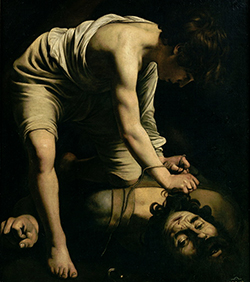 Painting by Caravaggio: David and Goliath The David and Goliath in the Prado was painted in the early part of the artist's career, while he was a member of the household of Cardinal Francesco Maria Del Monte. It shows the Biblical David as a young boy (in accordance with the Bible story) fastening the head of the champion of the Philistines, the giant Goliath, by the hair. The light catches on David's leg, arm and flank, on the massive shoulders from which Goliath's head has been severed, and on the head itself, but everything else is dark. Even David's face is almost invisible in the shadows. A wound on Goliath's forehead shows where he has been felled by the stone from David's sling. The overwhelming impression is of some action intensely personal and private — no triumph, no armies, no victory.
Painting by Caravaggio: David and Goliath The David and Goliath in the Prado was painted in the early part of the artist's career, while he was a member of the household of Cardinal Francesco Maria Del Monte. It shows the Biblical David as a young boy (in accordance with the Bible story) fastening the head of the champion of the Philistines, the giant Goliath, by the hair. The light catches on David's leg, arm and flank, on the massive shoulders from which Goliath's head has been severed, and on the head itself, but everything else is dark. Even David's face is almost invisible in the shadows. A wound on Goliath's forehead shows where he has been felled by the stone from David's sling. The overwhelming impression is of some action intensely personal and private — no triumph, no armies, no victory.
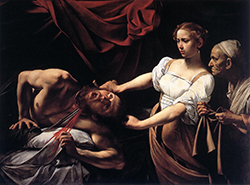 Painting by Caravaggio: Judith Beheading Holofernes The widow Judith first charms the Assyrian general Holofernes, then decapitates him in his tent. The painting was rediscovered in 1950 and is part of the collection of the Galleria Nazionale d'Arte Antica in Rome. The deutero-canonical Book of Judith tells how Judith served her people by seducing and pleasuring Holofernes, the Assyrian general. Judith gets Holofernes drunk, then seizes her sword and slays him: "Approaching to his bed, she took hold of the hair of his head." (Judith, 13:7-8). Caravaggio's approach was, typically, to choose the moment of greatest dramatic impact, the moment of the decapitation itself. The figures are set out in a shallow stage, theatrically lit from the side, isolated against the inky, black background. Judith and her maid Abra stand to the right, partially over Holofernes, who is vulnerable on his back. X-rays have revealed that Caravaggio adjusted the placement of Holofernes' head as he proceeded, separating it slightly from the torso and moving it slightly to the right. The faces of the three characters demonstrate his mastery of emotion, Judith in particular showing in her face a mix of determination and repulsion. Artemisia Gentileschi and others were deeply influenced by this work, and even surpassed Caravaggio's physical realism, but it has been argued that none matched his capture of Judith's psychological ambivalence.
Painting by Caravaggio: Judith Beheading Holofernes The widow Judith first charms the Assyrian general Holofernes, then decapitates him in his tent. The painting was rediscovered in 1950 and is part of the collection of the Galleria Nazionale d'Arte Antica in Rome. The deutero-canonical Book of Judith tells how Judith served her people by seducing and pleasuring Holofernes, the Assyrian general. Judith gets Holofernes drunk, then seizes her sword and slays him: "Approaching to his bed, she took hold of the hair of his head." (Judith, 13:7-8). Caravaggio's approach was, typically, to choose the moment of greatest dramatic impact, the moment of the decapitation itself. The figures are set out in a shallow stage, theatrically lit from the side, isolated against the inky, black background. Judith and her maid Abra stand to the right, partially over Holofernes, who is vulnerable on his back. X-rays have revealed that Caravaggio adjusted the placement of Holofernes' head as he proceeded, separating it slightly from the torso and moving it slightly to the right. The faces of the three characters demonstrate his mastery of emotion, Judith in particular showing in her face a mix of determination and repulsion. Artemisia Gentileschi and others were deeply influenced by this work, and even surpassed Caravaggio's physical realism, but it has been argued that none matched his capture of Judith's psychological ambivalence.
ESP Quick Facts
ESP Origins
In the early 1990's, Robert Robbins was a faculty member at Johns Hopkins, where he directed the informatics core of GDB — the human gene-mapping database of the international human genome project. To share papers with colleagues around the world, he set up a small paper-sharing section on his personal web page. This small project evolved into The Electronic Scholarly Publishing Project.
ESP Support
In 1995, Robbins became the VP/IT of the Fred Hutchinson Cancer Research Center in Seattle, WA. Soon after arriving in Seattle, Robbins secured funding, through the ELSI component of the US Human Genome Project, to create the original ESP.ORG web site, with the formal goal of providing free, world-wide access to the literature of classical genetics.
ESP Rationale
Although the methods of molecular biology can seem almost magical to the uninitiated, the original techniques of classical genetics are readily appreciated by one and all: cross individuals that differ in some inherited trait, collect all of the progeny, score their attributes, and propose mechanisms to explain the patterns of inheritance observed.
ESP Goal
In reading the early works of classical genetics, one is drawn, almost inexorably, into ever more complex models, until molecular explanations begin to seem both necessary and natural. At that point, the tools for understanding genome research are at hand. Assisting readers reach this point was the original goal of The Electronic Scholarly Publishing Project.
ESP Usage
Usage of the site grew rapidly and has remained high. Faculty began to use the site for their assigned readings. Other on-line publishers, ranging from The New York Times to Nature referenced ESP materials in their own publications. Nobel laureates (e.g., Joshua Lederberg) regularly used the site and even wrote to suggest changes and improvements.
ESP Content
When the site began, no journals were making their early content available in digital format. As a result, ESP was obliged to digitize classic literature before it could be made available. For many important papers — such as Mendel's original paper or the first genetic map — ESP had to produce entirely new typeset versions of the works, if they were to be available in a high-quality format.
ESP Help
Early support from the DOE component of the Human Genome Project was critically important for getting the ESP project on a firm foundation. Since that funding ended (nearly 20 years ago), the project has been operated as a purely volunteer effort. Anyone wishing to assist in these efforts should send an email to Robbins.
ESP Plans
With the development of methods for adding typeset side notes to PDF files, the ESP project now plans to add annotated versions of some classical papers to its holdings. We also plan to add new reference and pedagogical material. We have already started providing regularly updated, comprehensive bibliographies to the ESP.ORG site.
ESP Picks from Around the Web (updated 06 MAR 2017 )
Old Science

Weird Science

Treating Disease with Fecal Transplantation
Fossils of miniature humans (hobbits) discovered in Indonesia

Dinosaur tail, complete with feathers, found preserved in amber.
Astronomy

Mysterious fast radio burst (FRB) detected in the distant universe.